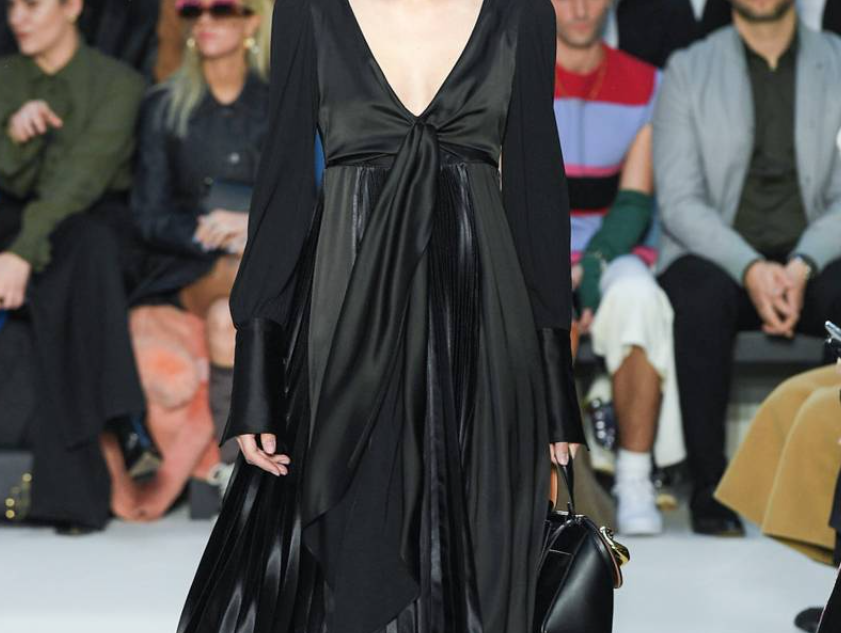
Pierpalo Piccioli's Valentino Spring/Summer 2019 haute couture show was a celebration of diversity, with more than half of the models being women of color. But haute couture Mondays, which tend to focus on old-fashioned glamour and fantasy, always lag behind when it comes to picking representative ensembles. Will other designers follow suit this season, or will it be business as usual?
Valentino Spring/Summer 2019 haute couture, held in the hallowed halls of HotelSalomon de Rothschild, was a tribute to old-fashioned glamour - showcasing floor-length dresses adorned with feathers, ruffles and painterly floral motifs - but the Italian mansion was certainly not confined to the past.
More than half of the models who walked the runway wearing Pierpalo Piccioli's lavish creations were women of color, making it the most diverse haute couture show on record. Leading the show was South Sudanese model AdutAkech, who wore a pink shawl and ruffled hood, while closing the show was Naomi Campbell, who returned to Valentino after a 14-year hiatus in a transparent black organza.
There's also the debut of Somali-American newcomer Ugbad Abdi; Catwalk regulars Alek Wek and LiyaKebede; And Chinese supermodels Liu Wen and He Cong. The show brought tears of joy to both Campbell on the runway and CelineDion in the front row, but it also exposed the reality of fashion Week's unequal casting.
Valentino remains an exception to the crowded schedule.
The diversity problem in fashion is industry-wide, but the statistics for ready-to-wear are improving all the time. The 2019 Fall Report found that this season's runways were the most racially diverse to date, with 38 percent of acting roles going to models of color (up 2.7 percent since spring/summer 2019).
But that's not the case at haute couture, where the numbers are significantly lower. In the 22 shows, only 26 percent of the models were people of color. The famous opening and closing ceremonies are also elusive. Akech opened the season at Givenchy, SelenaForrest at Dior and Tami Williams at Balmain, but the season's closing female leads were mostly white.
Chanel made history at their Fall/Winter 2018 show when they cast Akech as the leading lady of haute couture - only the second black woman ever to close a Haute Couture week, after Alek Wek in 2004.
"Shows like that are a symbol of progress in our industry," Akech told Vogue. "We're going to look back on them for many years to come, but I really hope they make more lasting change."
Naomi Campbell agrees: "The Valentino show is a good example. It took them four months to cast, and you can tell. It reminds me of the days when I signed with YvesSaint Laurent. He just wanted to make his clothes look more beautiful and aesthetically appropriate, so they took the time to get it right. They don't just use it and leave, you know?"
This relative lack of inclusivity is partly to blame for the quick casting approach. While Patrizia Pilotti, Piccioli's longtime Valentino casting director, personally selected the spring/summer 2019 line-up, many Parisian fashion houses still rely on agencies to provide them with models based in Paris.
Agencies, in turn, may not represent many models of color, and there is no financial incentive to send models to haute couture shows. "It's a realistic question," veteran casting director James Scully explained to Vogue. "Chanel, Dior, Givenchy and Valentino may fly them out to show for them, but not many fashion houses will send them to do commercials anymore." Walking the runway is not the most important part of a model's career, it doesn't pay very well, and no model gets more than one or two shows, especially models of color."
Casting issues aside, Scully believes haute Couture has a lot to improve. "It feels very incongruous," he added. "Fashion has to be democratic, but haute couture is completely out of the reach of ordinary people." Haute Couture is uniquely committed to tradition, fantasy and ancient craftsmanship, and its value system may prevent some brands from challenging the status quo, but it also encourages others to defy expectations.
A central part of Piccioli's vision for Valentino is the desire to bring haute couture into the 21st century. "When you think of haute couture, you think of the image of the past," the designer told Vogue. "
When haute couture was born, it was designed only for white women, no black women. Now, it's about beauty and luxury, but it can also be modern. It doesn't have to be in terms of clothes, but it can be modern in terms of the women who wear them, or it can be modern in terms of being inclusive."
Scully is confident that Valentino's transformation will be permanent. "The message of that show was very powerful," he said. "This time I hope to bring in some of those models again. Given their line-up at the recent menswear shows, I think this will become the norm for them. This is not a one-quarter manifesto."
Will Piccioli's success prompt others to follow suit? Perhaps, in terms of promoting greater racial diversity, but inclusion in other ways - including older, bulkier, transgender, non-binary and disabled models - also needs to be on the agenda.
Spring/summer 2019 also saw 71-year-old Maye Musk walk the Dundas runway and transgender model and activist Teddy Quinlivan stole the show at the Alexandre Vauthier show.
Going forward, we aim to make this the norm, rather than an occasional talking point - something that haute couture's increasingly global millennial clientele will certainly appreciate. "I think haute couture is an extreme expression of duality and diversity," Piccioli added, in a nod to its tailored approach. "It's all about personality."
The eye-catching silhouettes, luxurious fabrics and decadent venues will remain as they have been for a century in Paris this week, but the faces on the catwalk are slowly changing - and in the end, that could be one of its highlights.

